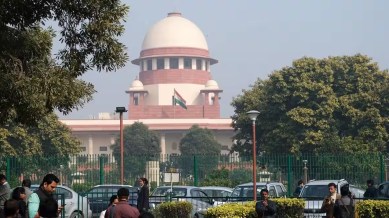Stay updated with the latest - Click here to follow us on Instagram
Special Marriage Act: Supreme Court says smaller bench can look into issues
In its 366-page ruling, the Supreme Court indicated that this was not a question of law that necessitated a five-judge bench ruling. “Hence this issue was to be left for consideration by a numerically smaller bench,” the court said.

Drawing the curtain on the question of same-sex marriage under the Special Marriage Act (SMA), 1954, the five-judge Constitution Bench, led by Chief Justice of India D Y Chandrachud and comprising Justices S K Kaul, S Ravindra Bhat, Hima Kohli and P S Narasimha, also ruled against “civil unions” for non-heterosexual couples in a 3:2 verdict.
During the course of the hearing, from April to May, some senior advocates like Abhishek Singhvi and Raju Ramachandran attempted to address the “notice and objections regime” in the SMA, under Sections 5-9, which stipulate a set of procedural preconditions for solemnisation of marriages under the Act.
monthly limit of free stories.
with an Express account.
In its 366-page ruling, the Supreme Court indicated that this was not a question of law that necessitated a five-judge bench ruling. “Hence this issue was to be left for consideration by a numerically smaller bench,” the court said.
On May 10, when the court was examining the arguments for a neutral reading of the SMA to allow recognition of marriage between any two persons, Singhvi, appearing for a petitioner, said that personal laws in the country “don’t discriminate unlike the SMA”, while arguing against the mandatory 30-day notice period in it.
To this, the court responded that the mandatory 30-day notice inviting public objections to an intended marriage under the SMA is “patriarchal” and makes it “open for invasion by society”. While Justice Bhat said these patriarchal laws were made “when women did not have an agency”, CJI Chandrachud noted that “this is like laying them open for invasion by society, including the Superintendent of Police, the District Magistrate, etc”. Additionally, the CJI said if the intent behind the notice period was to prevent possibly unlawful marriages, the method was not proportional.
The 30-day notice period is referred to in Section 5 of the SMA, which says that parties to a marriage are required to give a notice, in writing, to a “marriage officer” of the district in which at least one party has resided for at least 30 days before giving the notice. Section 6 says that once the officer receives notice, he shall publish it in his office conspicuously, inviting objections to the marriage within 30 days.
Reminding the court that it had earlier said it wouldn’t consider this aspect, Solicitor General Tushar Mehta, on behalf of the Centre, said, “We didn’t respond to this. Your Lordship said will not go into this notice…”
This led the CJI to say that the notice-period aspect “will be dealt with separately”. However, Singhvi reminded the court that petitions filed by him and Ramachandran were already pending before the court on this aspect. The CJI said the “notice applies to those who are entitled to marry undoubtedly”, thereby hinting at its irrelevance in the present case owing to the petitioner’s absence of such a right to marry in the first place.